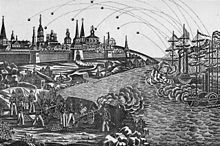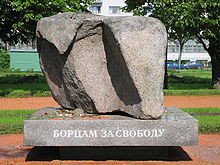Solovetsky Islands
 Kislaya Bay of Bolshoy Solovetsky Island | |
 Map of the White Sea showing the Solovetsky Islands | |
| Geography | |
|---|---|
| Location | Onega Bay, White Sea |
| Coordinates | 65°05′N 35°53′E / 65.083°N 35.883°E |
| Area | 347 km2 (134 sq mi) |
| Administration | |
Russia | |
| Oblast | Arkhangelsk Oblast |
| Capital and largest city | Solovetsky |
| Demographics | |
| Population | 861 (2010) |
| Official name | Cultural and Historic Ensemble of the Solovetsky Islands |
| Type | Cultural |
| Criteria | iv |
| Designated | 1992 (16th session) |
| Reference no. | 632 |
| Region | Europe and North America |
The Solovetsky Islands (Russian: Соловецкие острова, IPA: [səlɐˈvʲetskʲɪj ɐstrɐˈva]), or Solovki (Russian: Соловки, IPA: [səlɐfˈkʲi]), are an archipelago located in the Onega Bay of the White Sea, Russia. As an administrative division, the islands are incorporated as Solovetsky District of Arkhangelsk Oblast, Russia.[1] Within the framework of municipal divisions, they are incorporated as Solovetskoye Rural Settlement within Primorsky Municipal District.[2] The administrative center of both divisions is the settlement of Solovetsky, located on Bolshoy Solovetsky Island. Almost all of the population of the islands lives in Solovetsky. As of the 2010 Census, the district had a population of 861 inhabitants.[3]
The Solovetsky Monastery (founded in 1436), in 1923 became the site of the first Gulag establishment, the Solovki prison camp.
Geography
The archipelago has a total area of 347 square kilometers (134 sq mi) and consists of six islands:

- Bolshoy Solovetsky Island, 246 km2 (95 sq mi)
- Anzersky Island (Anzer), 47 km2 (18 sq mi)
- Bolshaya Muksalma, 17 km2 (6.6 sq mi)
- Malaya Muksalma 0.57 km2 (0.22 sq mi)
- Bolshoy Zayatsky Island, 1.25 km2 (0.48 sq mi)
- Maly Zayatsky, 1.02 km2 (0.39 sq mi)
The islands separate the Onega Bay from the main volume of the White Sea. The closest mainland is the Onega Peninsula.
The shores of the islands are very indented. They are formed of granites and gneiss. The relief of the islands is hilly (the highest point is 107 m). Most of the Solovetsky Islands are covered with Scots Pine and Norway Spruce forests, which are partially swampy. There are numerous lakes, which were joined by monks so as to form a network of canals.
One interesting feature of these islands is stone labyrinths and other stone settings, especially the Stone labyrinths of Bolshoi Zayatsky Island. Such labyrinths were typical for Northern Europe, but most have perished and now Solovetsky Islands have some of the best remaining examples.
Monastery
Historically the islands have been the setting of the famous Russian Orthodox Solovetsky Monastery complex. It was founded in the second quarter of the 15th century by two monks from the Kirillo-Belozersky Monastery. By the end of the 16th century, the abbey had emerged as one of the wealthiest landowners and most influential religious centres in Russia.

The existing stronghold and its major churches were erected in stone during the early reign of Ivan the Terrible at the behest of St. Philip of Moscow. At the onset of the Schism of the Russian Church, the monks staunchly stuck to the faith of their fathers and expelled the tsar's representatives from the Solovki, precipitating the eight-year-long siege of the islands by the forces of Tsar Alexis.

Throughout the imperial period of Russian history, the monastery was renowned as a strong fortress which repelled foreign attacks during the Livonian War (16th century), Time of Troubles (17th century), the Crimean War (19th century), and the Russian Civil War (20th century).
In 1974, the Solovetsky Islands were designated a historical and architectural museum and a natural reserve of the Soviet Union. In 1992, they were inscribed on the World Heritage List "as an outstanding example of a monastic settlement in the inhospitable environment of northern Europe which admirably illustrates the faith, tenacity, and enterprise of later medieval religious communities".[4] Today, the Solovki are seen as one of the major tourist magnets in the orbit of the Russian North.[citation needed]
Labor camp

After the October Revolution, the islands attained notoriety as the site of the first Soviet prison camp (gulag).[5] The camp was inaugurated in 1921, while Vladimir Lenin was still at the helm of Soviet Russia. It was closed in 1939, on the eve of World War II. By the beginning of the war, there was a naval cadet training camp for the Soviet Northern Fleet.
Transportation
The islands are served by the Solovki Airport. There is regular air service to Arkhangelsk, as well as ferry lines (summertime only) to Arkhangelsk, Kem, and Belomorsk.
See also
References
Notes
- ^ Law #65-5-OZ
- ^ Law #258-vneoch.-OZ
- ^ Russian Federal State Statistics Service (2011). Всероссийская перепись населения 2010 года. Том 1 [2010 All-Russian Population Census, vol. 1]. Всероссийская перепись населения 2010 года [2010 All-Russia Population Census] (in Russian). Federal State Statistics Service.
- ^ "Cultural and Historic Ensemble of the Solovetsky Islands". UNESCO World Heritage Centre. Retrieved August 10, 2011.
- ^ Aleksandr Solzhenitsyn (1975). The Gulag Archipelago. Collins & Harvill Press. p. Vol. 2, Part III, Chapter 2.
Sources
- Архангельское областное Собрание депутатов. Областной закон №65-5-ОЗ от 23 сентября 2009 г. «Об административно-территориальном устройстве Архангельской области», в ред. Областного закона №232-13-ОЗ от 16 декабря 2014 г. «О внесении изменений в отдельные Областные Законы в сфере осуществления местного самоуправления и взаимодействия с некоммерческими организациями». Вступил в силу через десять дней со дня официального опубликования. Опубликован: "Волна", №43, 6 октября 2009 г. (Arkhangelsk Oblast Council of Deputies. Oblast Law #65-5-OZ of September 23, 2009 On the Administrative-Territorial Structure of Arkhangelsk Oblast, as amended by the Oblast Law #232-13-OZ of December 16, 2014 On Amending Various Oblast Laws Dealing with the Process of Municipal Self-Government and Relations with Non-Profit Organizations. Effective as of the day which is ten days after the official publication.).
- Архангельское областное Собрание депутатов. Областной закон №258-внеоч.-ОЗ от 23 сентября 2004 г. «О статусе и границах территорий муниципальных образований в Архангельской области», в ред. Областного закона №224-13-ОЗ от 16 декабря 2014 г. «Об упразднении отдельных населённых пунктов Соловецкого района Архангельской области и о внесении изменения в статью 46 Областного закона "О статусе и границах территорий муниципальных образований в Архангельской области"». Вступил в силу со дня официального опубликования. Опубликован: "Волна", №38, 8 октября 2004 г. (Arkhangelsk Oblast Council of Deputies. Oblast Law #258-vneoch.-OZ of September 23, 2004 On the Status and Borders of the Territories of the Municipal Formations in Arkhangelsk Oblast, as amended by the Oblast Law #224-13-OZ of December 16, 2014 On Abolishing Several Inhabited Localities in Solovetsky District of Arkhangelsk Oblast and on Amending Article 46 of the Oblast Law "On the Status and Borders of the Territories of the Municipal Formations in Arkhangelsk Oblast". Effective as of the day of the official publication.).
Further reading
- Brumfield, William. Solovki: Architectural Heritage in Photographs (Moscow: Tri Kvadrata, 2008). ISBN 978-5-94607-052-2. OCLC 255613915. In English and in Russian.
- Robson, Roy. Solovki: The Story of Russia Told Through Its Most Remarkable Islands (New Haven: Yale University Press, 2008). ISBN 9780300129601.
